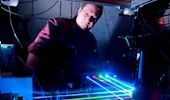The Condensed Matter & Surface Sciences Colloquium Series presents Eric Stinaff of Ohio University on “2D Crystals.” on Thursday, Sept. 10, at 4:10 p.m. in Walter 245.
Abstract: The ability to use atomically thin crystals in devices having electronic, magnetic and optical multi-functionalities is one of the emerging challenges in materials research today. Examples of these materials include MoS2, NbSe2, and TaS2, although many more exist. TMDs exhibit a variety of physical properties, from semiconducting to metallic and even superconducting behavior. Our lab has recently begun investigating the optical properties of MoS2 and WS2 in collaboration with Prof. Kordesch. Our immediate goals include CVD growth optimization of TMDs over large area substrates, the exploration of optical and electronic-transport behavior in hybrid superstructures where TMDs are used in conjunction with different adsorbates and substrates, and fundamental studies of single elemental units of coupled systems. Initial results that will be discussed involve the measurement of carrier dynamics using ultra-fast pump-probe techniques. Previous femtosecond transient absorption spectroscopy experiments have focused on the exciton dynamics of the two direct emission peaks A and B that are related to spin orbit coupling in the valance band. Here we present an experimental investigation of mono-to-few layer sheets of MoS2 and WS2 employing femto-second transient absorption spectroscopy and microscopy with a broadband probe to explore simultaneously, ground and excited state dynamics. The sample was pumped resonantly at different absorption peak positions and then probed with a white-light continuum over the spectral range of 350 nm – 800 nm. We observe previously reported features related to ground state bleaching along with higher energy features that can be related to excited states. The positions of the excited states are consistent with previous non-time-resolved absorption experiments. Here we report new results on the dynamics of these states which may prove useful to a greater understanding of the electronic structure of this material.




















Comments